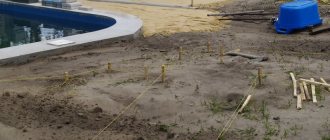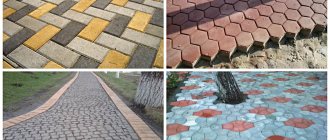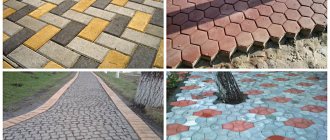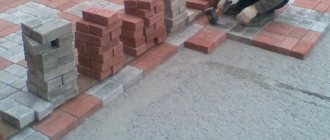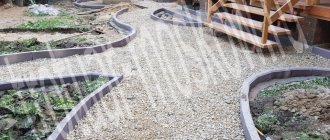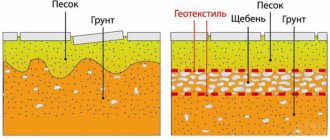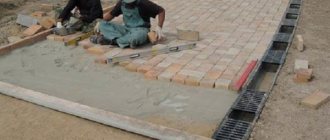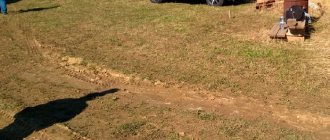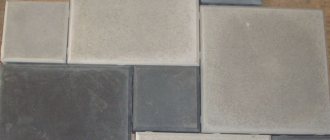Principles of constructing a diamond pattern
Laying schemes have been developed for the predominant number of figured paving elements (FEM). Installation technology includes displacement of longitudinal seams or tiles in rows, and the use of fragments that differ in color tone.
Diamond-shaped paving elements are distinguished by central, axial and mirror symmetry. This configuration ensures correct laying of the canvas. During installation, it is possible to use various options for the location of the FEM. The elements can touch each other with their side faces, and from 3 rhombuses you can lay out a regular 6-sided shape.
Using 6 products in a composition allows you to create a star. The diamond configuration ensures installation without trimming, which reduces the cost of arranging the fabric. From 3 shades of the main color it is possible to create a three-dimensional pattern with a 3D effect.
How to choose the right paving slab laying scheme
Today, the following installation methods are used in practice: on a sand bed, on a cement-sand mixture, on a cement/sand solution. Before installing the material in any way, it is necessary to properly prepare the base - remove the layer of soil. If the master designer wants to lay it on a layer of earth overgrown with vegetation, in addition to sand, it will be necessary to fill in a layer of crushed stone and level the surface. Sand is poured onto crushed stone in a layer of 50-100 mm.
Different layouts of paving slabs can form different pattern combinations
In the first, least labor-intensive case, the material may be placed directly on wet sand. This is a good installation option for garden paths; almost no water will collect on them; it will seep through the seams and go into the ground. But it’s difficult to call this method thorough. The second method does not take much effort, but it is the most reliable. To create the composition, you need to mix cement and sand in proportions of 1 to 5.
Then the mass must be distributed over the area and sprinkled onto the tile laying. After installation is completed, the path must be shed with water. The water will allow the mixture to set better. Installing tiles with cement-sand mortar is considered the most durable option, but doing such work is not easy. It is difficult to mix the solution manually, so special equipment for mixing concrete is useful. The proportions of cement and sand are the same 1 to 5. The mixture must be poured onto the base and leveled using a trowel. The solution layer is 30-40 mm.
For masonry you need to use a rubber mallet. If the installation is done without a slope, you need to make gutters for water drainage. The methods listed above for arranging paving materials will help you make the choice, but this is only half the battle. It is very important to lay tiles professionally; the coating must be practical and durable.
We must not forget about the drawing; design matters for the overall picture. The use of paving slabs of different colors, with an interesting texture, can create a coating that is original in beauty. The scheme must be clearly thought out, a laying program must be developed, only then the design will be of high quality and will delight you for many years.
The layout of paving slabs can be quite simple, when you need to combine 2 colors of the material in a well-thought-out order, or complex.
Before laying, you need to decide on the type of paving slabs, the dimensions and location of their installation, as well as the technology for performing the work.
With the help of a complex one it is possible to create an original one:
- Pattern;
- Drawing;
- Ornament;
- Plot.
For paving an area in the yard or a path in the garden, it is possible to choose the classic version of the material - brick. Despite the simplicity of their shape, multi-colored rectangles can be successfully combined to form interesting patterns. And if you give preference to figured tiles, then, as the samples demonstrate, the work will look even more original.
You can arrange the material in several ways, each of which is original.
Textured tiles are a good option for the garden, allowing you to create original patterns and combinations
Methods:
- Herringbone and wicker. Anyone can make the Herringbone pattern by laying out the material at a traditional angle - 90-45°. Wicker is a subtype of herringbone, when the tiles alternate and resemble interlacing. The braid is made by alternating laying lengthwise/crosswise.
- Chaos. A simple method that will help you create a unique design is a random mixture. To create a chaotic pattern, you need to take material of different colors and sizes, and lay the tiles randomly. It's quite simple, and the result is a beautiful composition, somewhat reminiscent of an old city.
- Chess. 2-color tiles in the shape of a square, arranged in a checkerboard pattern, always look successful. Can be used to create cells of 2 bricks.
- Circle. Among examples of paving a site, the layout in a circle occupies a special place. The circular pattern makes it possible to create a spectacular platform in front of the cottage, a resting place in the garden. If the pattern is made by a professional, then he may not follow the standard pattern, creating magnificent designs that look original both in a normal position and from a height.
The tiles and lawn are combined very successfully and unusually. If you cover a section of the lawn with tiles or arrange a neat flower bed in the central part of the path or area, it will always look impressive. This is an element of landscape design, using which you can create your own attractive corner that will amaze your household and neighbors.
READ MORE: How and what to paint a painted floor without removing the old paint
Modern manufacturers offer a huge selection of paving tiles. The species are available in abundance on the market. Various schemes are used for installation. Some patterns are made both independently and, if there is space, can successfully fit into another pattern.
In order to recreate a specific pattern, you must first reproduce it on paper
The most daring ideas can be brought to life, but the most relevant are the following:
- Rhombus. On sale you can find a large selection of tiles with this geometric shape. The abundance of colors, textures, and shapes makes it possible to create drawings with a 3D effect. Once you become familiar with the nuances of installing diamond-shaped elements, you can lay out different patterns. Examples: snowflake, star, flower. Usually 3 bright colors are used. The pattern can be made vertical or horizontal. Before installation, you need to outline the central part of the symmetry.
- Wave. Rectangular tiles with a wave edge look great when arranged in a checkerboard pattern horizontally or vertically, as well as diagonally or in a brickwork pattern. Wave tiles are universal; they can transform any garden area. It has a high side contact area on the sides, which ensures uniform load over the entire surface.
- Clover. The original form of this material makes it possible to create interesting coating options. It may be smooth or, on the contrary, rough. The combination of colors, textures and sizes of paving material makes it possible to create incredibly beautiful coatings.
Another interesting pattern is the shell. Laying it out is not difficult, you can take tiles brick by brick.
Many types of installation of paving slabs have been developed, this building material is affordable and a small garden will not need much of it, and in combination with other decorative means it will help the home craftsman beautifully decorate the yard and bring harmony and comfort to the garden.
Beautiful and aesthetic paving is created as a result of painstaking work and well-thought-out site planning. In addition to the imagination and wishes of the owners, the choice of paving scheme is influenced by:
- landscape features;
- site architecture;
- place of installation and its purpose;
- dimensions and configuration of the site.
Street tiles for paths are used as one of the elements of landscape design. This is an exclusively design product: the installation pattern affects the visual perception of the coating. With its help you can model space. Paving slabs are a durable material. Therefore, the choice of installation scheme must be approached carefully.
This article will tell you what plastic tiles for paths in the country are.
Paving of areas is done for parking or for recreation areas. Depending on the purpose of the site, the paving method and tile sizes are chosen. For the courtyard, classic rectangular tiles are often used. Original patterns are obtained by alternating tiles of different colors at the right angle and using a specific pattern.
All information about the texture of paving slabs is presented at this link.
Sidewalks and platforms made of decorative slabs are durable, wear-resistant, and environmentally friendly.
- rubber hammer;
- mallet;
- building level;
- rake;
- cord;
- pegs;
- watering hose;
- tamping;
- channel.
- elements of the same size, shade and shape can be laid out according to a pattern or in a chaotic order;
- in collections, tiles have a short and an elongated side, so laying diagonally, across or along the path is possible;
- installation involves the design of platforms and elongated paths;
- slabs can be laid offset, imitating brickwork, at right angles, in pairs;
- For standard blocks, 5-6 laying methods have been developed;
- using rectangular paving stones you can create borders;
- paving stones are used when decorating lawns, radiuses, intersections, and courtyard areas;
- Parts of different thicknesses are not used for paving, because It will require large expenses to level the sand cushion.
Rules for making an ornament pattern
Thanks to the correct geometric shape, the tiles can be laid in a simple way, in which identical edges are joined to each other. Visual effects are achieved through the use of fragments of different colors.
When arranging the canvas, the seams do not move, but the tile itself is easily laid on winding or radial sections. This installation feature is used in landscape design and allows you to emphasize the stylish design of the area. The tile will need to be cut, since in its original form the diamond will fit into the border without preserving the pattern of the canvas.
When laying, the side edges of the row are pressed against the curb using an even number of rows, which ensures mirror symmetry. Even in this installation option, FEM halves are used.
Characteristics of rhombus tiles
The popular material is used to decorate pedestrian areas.
Paving slabs “Rhombus” have the following characteristics:
- ease of installation;
- ease of care;
- increased stability;
- environmental cleanliness.
The building materials market is represented by a wide selection of products of this type in different price ranges.
Benefits of use
You can arrange the territory with the help of FEM “Rhombus” yourself. Thanks to the configuration and correct shape, errors are eliminated during installation. By combining different shades you can create three-dimensional patterns.
In the manufacture of FEM, materials are used that are characterized by increased resistance to environmental influences. Manufacturing technology using vibration casting and pressing ensures the reliability and durability of the canvas. Additional components are used in production to eliminate the formation of voids during the formation of the product.
Sizes and colors
There are no parameters for “Rhombus” paving stones in the State Standard, so manufacturers produce shaped paving elements according to individually developed technical conditions. The configuration and dimensions of the tiles are in the range of 140x240 mm - 190x330 mm (the length is determined by the diagonals of the product).
Thickness varies between 4-7 cm. This parameter of products is taken into account when choosing. It is recommended to lay the canvas with maximum deformation and weight load using paving stones 7 cm thick.
The building materials market offers products from companies that offer additional elements. The delivery of FEM can be completed with halves of tiles in length and width. This choice saves time. When laying, the need to cut tiles is eliminated.
According to calculations, the halves of the diamond should reduce the cost of arranging the canvas, but their high price balances the cost item associated with additional processing of the elements.
The advantage of purchasing is the reduction of waste and the volume of construction waste. The “Rhombus” tile has a chamfer on the front side, which allows you to create designs that are distinguished by high aesthetic perception.
Manufacturers of figured elements in Moscow offer customers a range of products made in a wide color spectrum. The manufacturing technology involves the use of mineral dyes, which ensure the resistance of products to ultraviolet rays. When laying the canvas, borders of different colors can be used.
Features of figured paving elements
Before choosing a coating of this format, it is recommended to pay attention to its characteristics. The standard size of FEM is 197 mm (on the side of the rhombus), the thickness of the products is 6-7 mm. The longitudinal half has a length of 310 mm, a width of 95 mm, and the transverse element is 190 and 165 mm, respectively.
The production of rhombic tiles is labor intensive. The finished product must meet the requirements. FEM packaging is not allowed to contain defects or white spots. The manufacturer pays special attention to the formation, drying and storage of products.
In most cases, the front part has a smooth surface. The version of products with a shagreen side is suitable for laying sidewalks with a large flow of pedestrians. Rough tiles provide better grip on the soles of shoes and prevent slipping.
Various colors are used when painting products. The addition of a mineral component to the mass or top layer of the tile depends on the manufacturing technology used. When choosing paving stones, you need to pay attention to the condition of the products. Minor defects can cause damage to the canvas.
The main stages of paving with tiles
Paving slabs are a strong and durable material that comes in a wide range of colors and various shapes. There are several dozen options for laying paving stones, each of which will be a worthy addition to the country landscape.
To work, the master will need the following tools:
- cord for marking and pegs;
- rake, broom, tamper;
- rubber hammer, wooden mallet;
- building level, channel;
- watering hose.
Materials for work:
- crushed stone or gravel mixture;
- sand;
- cement or dry plaster;
- geotextiles;
- paving slabs.
READ MORE: Simple repair of cracks in brick and concrete walls: step-by-step instructions
Stage 1: preparation
In the area chosen for laying paving stones, you need to remove the top layer of soil with grass and roots. If for some reason this is not possible, an embankment of crushed stone and sand is made on the soil. Curbs are installed along the edges of the embankment.
Advice! It is better to lay a geotextile fabric between the materials, otherwise the sand will spill through the crushed stone fractions.
The base for laying the tiles is filled with sand (a layer of at least 8-10 centimeters) and carefully compacted. Experts recommend pouring water over the sand from a hose with a sprayer. Such a sand cushion will relieve the paving stones from problems with stagnant water after rain.
Advice! For more reliable fastening of paving slabs, you can add a fifth of cement or plaster to the sand. In this case, there is no need to water the pillow.
The prepared base is leveled with a rake. You can use a channel for leveling. Profiles or pipes are used as guides.
Stage 2: paving
Before laying the first element of paving stones, it is important to have a drawing of the future installation or diagram before your eyes.
During the work process, paving slabs are laid in the direction “away from you”, diagonally. Each element is tightly adjusted to the previous ones using a mallet.
After the paving is completed, the surface is leveled with a rubber hammer, and the result is checked with a building level. The finished paving stones are covered with a cement-sand mixture. The excess mixture is swept away.
After laying, the area is watered abundantly. Water will penetrate the seams between the paving elements and provide strong adhesion between the cement-sand mixture and the tile material.
Stage 3: care
Paving slabs are a reliable and durable material, but they also require maintenance. Periodically you need to sweep away dust and debris and clean out clods of dirt. It is better to wash the colored coating of paving stones occasionally, so it will retain its brightness longer. Fallen and loose elements are laid out in a new way
Important! Do not use metal objects (shovels, crowbars) or use salt or chemicals to remove ice and snow from the tiles. It is better to use regular sand.
Plain paving slabs
The use of unpainted fragments when arranging the canvas does not affect the aesthetics of perception. Instead of multi-colored FEM, you can use products with a relief pattern on the front side. To ensure traffic safety in icy conditions, the fragments are laid at an acceptable distance from each other.
The quality of the coating increases when using luminous tiles, which are used in limited quantities. Installation of a winding covering requires cutting of fragments. When using a plain diamond on the canvas, such elements are visually hidden.
Diamond tile layout patterns
When designing a walkway, designers place 2 contrasting colors, forming longitudinal or transverse stripes. The play of light and shadow provides a spectacular perception of volume. A multi-colored ornament requires an accurate calculation of the number of styling elements.
Star
Laying an ornamental composition of this type is possible on a large canvas. To complete the “Star” pattern you need 6 plain tiles. The installation technology involves connecting fragments at an acute angle at 1 point in space. In order to emphasize the design, elements of a different color are placed along the contour. Such compositions can be in contact with each other or be laid out in a chaotic manner.
Hexagon
The technique of making a 6-sided or cubic pattern involves joining the obtuse angles of 3 single-color stones at a single point. The result is a pattern that does not need to be emphasized by an outline of a different color.
When the obtuse angles of 3 elements of a single-color tile are joined, a 6-sided tile is obtained, which next to the “Star” layout will look disproportionate. When using a pattern with hexagons, you can achieve a volumetric effect.
In this case, you need to repeatedly use a combination of fragments of 3 colors. A visual increase in the volume of the cube gives the composition uniqueness.
3d effects
To achieve a three-dimensional visual perception of the pattern during installation, you need to create a 6-sided pattern using FEM of a rhombic configuration. The composition must be repeated many times when arranging the canvas. The originality of the drawing can be increased by changing the dimensions of the cube or its individual faces.
When using a three-dimensional layout of fragments, experts recommend placing dark tiles in the lower part, and an element made in a light tone at the top. The effect of a flight of stairs is achieved by placing a dark and light diamond on the sides, and a fragment of a neutral color at the top.
Visually this pattern resembles an accordion. By combining some shades you can get a flower-shaped pattern. In this case, you will get a flat two-dimensional image.
Geometric pattern
Simple patterns can be used to decorate the site. In this case, the canvas can be laid in the form of geometric shapes, continuous, intermittent, periodic or chaotic composition.
Repeating 6-sided shapes look great in the design of concentric circles or radius sections. On large areas, schematic ornaments in the form of stars and snowflakes are used.
Features of figured paving elements Rhombus
The developer must take into account that Rhombus paving slabs have the following features:
- standard format – diagonals 329 x 190 mm, diamond side 197 mm, thickness 6 cm or 7 cm;
Standard tile size Rhombus.
- longitudinal half – length 310 mm, width 95 mm;
- transverse half – length 190 mm, width 165 mm;
- labor intensity – high due to small size;
- laying patterns - “star”, “hexagon”, 3D, patterns and ornaments;
Paving scheme "Star".
- the front part is smooth, convex relief when produced by vibration casting, rough when produced by vibration pressing;
- coloring - in the mass or the top 3 cm layer, about 40 shades.
Important! When choosing this collection of shaped paving elements, the developer will need more space for storing the cladding than for large format tiles, for example a 50 x 50 cm square.
Pattern schemes for colored femme
The classic version of laying paving slabs “Rhombus” involves a combination of white, burgundy and gray colors. On a large area, a star can be made from a FEM of this configuration. For such paving, you need to draw a pattern and carefully mark the surface. Using this type of masonry you can achieve a three-dimensional image.
It is difficult to lay out a rhombus according to a figured template. The installation process requires compliance with the specific color scheme and direction of each fragment. Paved areas add interest to any landscape. To achieve a better effect, use textured fragments. To create patterns, modern designers use special computer programs.
Benefits of using diamond tiles
The popularity of paving slabs, including diamond paving stones, is due to their many advantages:
- It is possible to create interesting patterns.
- The products are not afraid of temperature changes, therefore they are used in almost all regions of Russia.
- UV resistant. Even prolonged exposure to the tile does not affect its characteristics.
- There are different types of paving stones on the market.
- Paving slabs are durable and do not lose their original attractiveness for years. The service life is more than 20 years.
- Environmentally friendly material, frost-resistant and moisture-resistant.
- The material is made by vibration pressing, so its wear resistance is very high.
- High strength indicators. The size of paving slabs is small, 150 × 200 and 190 × 250 mm, and the thickness is impressive - from 45 to 70 mm, which makes the products durable.
- Non-slip surface.
- Convenience and speed of installation and dismantling. Laying diamond paving slabs yourself is quick.
- The paved surface is easy to maintain as dirt does not accumulate on it. Just spray the surface with a stream of water from a hose, and it will become clean and beautiful again.
Advice! Paving with a colored diamond looks attractive on a not too large area. Other types can be used to pave large areas, so when choosing tiles, always take into account the size of the area that needs to be paved.
Diamond paving of difficult areas
On winding and radial paths, various installation methods are used. These areas require a large number of tiles to be trimmed, but proper geometry and vertical symmetry provide a dramatic reduction in waste. The scraps are used on the opposite side of the canvas.
“Rhombus” paving slabs are recommended to be laid on straight paths, which will reduce the labor intensity of the process. Laying tiles requires an integrated approach. To implement a landscaping project, it is recommended to contact specialists.
The company's comprehensive services include consultations with material selection, delivery and installation. Installation is carried out by specialists in compliance with technology and work guarantee.
How to choose a pattern for paving?
The shelf life of slabs in site design is 40-50 years; the type of pattern must be suitable in terms of functionality and design.
When selecting a scheme for paving a sidewalk or site, the following factors are taken into account:
- dimensions and shape of paths and platforms;
- landscape features of the territory;
- general color scheme of the buildings on the site;
- purpose of the space (play area, parking lot, pedestrian path, roadway, etc.);
- architectural features of the allotment buildings.
Paving stones are used for areas that can withstand intense loads, for parking lots, and sports grounds. For complex design solutions, figured tiles are used. Complex mosaics can be created using stones of different proportions and dimensions.
For straight sections, rectangular slabs are used; the shape of the blocks is not suitable for curved paths.
Single-color elements are used in the design of areas adjacent to the path; to decorate the main path, a combination of more than 2 tones is required. If there are differences in heights on the site, it is necessary to select a multi-stage installation.
To decorate small areas, do not use figured blocks of different shades, because... a complex coating pattern will visually reduce the space. Simple elements with a smooth surface will visually expand the space. Squares and rectangles are universal for different paving patterns.
READ MORE: Concrete paint for exterior use: types and properties
The selection of a tile laying scheme depends on many factors:
- size and shape of the site and paths;
- landscape features of the site;
- purpose of the paved area;
- architectural features of buildings.
It is worth considering that the service life of paving slabs is very long (up to 40-50 years). Therefore, it is important to take a balanced approach to choosing a paving pattern.
Important! Areas covered with paving stones are used for recreation or parking. In the latter case, you need to choose a material that can withstand heavy loads.
Most often, classic rectangular paving slabs are used. Alternating two or more colors and laying paving elements in a certain sequence allows you to create original patterns.
Laying figured tiles is more difficult, but with its help you can achieve excellent results.
